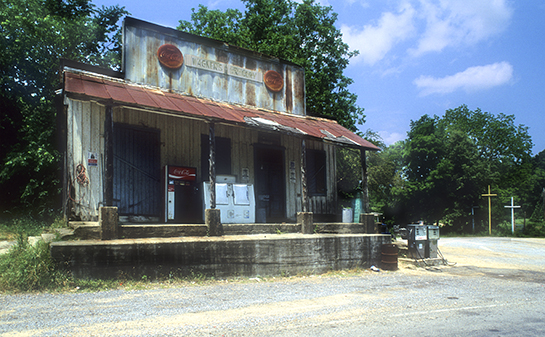

Sunday, March 2, 2008
Wagner's Grocery closed in the late Nineties. This shot was made in April, 1995, so the business was probably on life support by then. The store, in the Church Hill community, 18 miles north of Natchez, Mississippi, was built around 1837. It housed the local post office, and one can presume that the store was the epicenter of what was happening in that neck of the woods for many a year.
Fortunately, when death-knell sounded for the store, the property was donated to the Church Hill Historic Society. The society, according to internet sources, has raised more than $24,000 to restore the store. Makes one wonder if a hundred years or so from now, will local residents raise money to preserve strip malls and convenience stores? Fat chance.
Church Hill, other than the elevation above sea level, bears the name due to the presence of Christ Episcopal Church, situated across the road from the store. The church building, which I plan to feature in subsequent posts, was completed around 1858 by a congregation that began worshiping together in 1815. The area is listed on the National Register of Historic Places as a Rural Historic District.
Close inspection of the building reveals rough-cut cedar tree logs serving as supports for the porch overhang. The large door to the left no doubt facilitated a feed and hay business at some time. The high porch made it easy to load your purchases into your wagon or, later on, into the bed of your pickup.
Signage on the store is typical of the fifties. In that day and time, many bottlers had an in-house sign painting department. Signs bearing the store name sandwiched between the brand identification of the particular "cole-drank," marketed by that world-famous bottler, were furnished to merchants.
Lettering on the sorely faded sign was rendered in two shades of puke green, popular with sign painters of that era. The sign has at its center an original Coke bottle, which many of us fondly remember as costing a nickel. One of these effervescent elixirs, laced with a bag of nickel peanuts, was the de rigueur treat of the era. It could also serve as a cheap lunch before payday. Budget permitting, such fare was best followed by a Moon-Pie.
When you look at this store, it's not a stretch to imagine that Jerry Clowers' legendary Ledbetter family could have been regular customers.
They probably picked up their copies of the eagerly anticipated "Ladies Birthday Almanac" from a well-scarred counter. Uncle Versie could get some Cotton-Boll Twist chew, grandma Ledbetter probably got her Garrets four-dot snuff there, and Marcel probably pumped his chain-saw gas into a recycled glass Purex jug. Lydia E. Pinkam's Vegetable Compound for women was no doubt on the shelves or in a glass-enclosed retail fixture, as well as Black Draught, Cardui, and later on, the fifties miracle drug, Hadacol.
By the way, the ill-informed spell checker in the bowels of this computer does not recognize Hadacol. Bill Gates, are you culturally deprived?
N O T E S:
Nikon N90s / Nikkor 20mm f2.8 D, tripod perched / Fujichrome / Scanned with Nikon Coolscan 5000ED / Post processed with Photoshop CS3 Extended
Click the jump wings
to see the previous Photo of the Week. . . .

|


